More Fun with Jaguar Cacao
Reporting my Theobroma bicolor fermentation experiments for the year - how do the unfermented, short ferment, and long ferment compare?
Jaguar cacao season! Our most mature Theobroma bicolor tree had five precious fruits this year (up from three last year). What did I do with these pods? Read on!
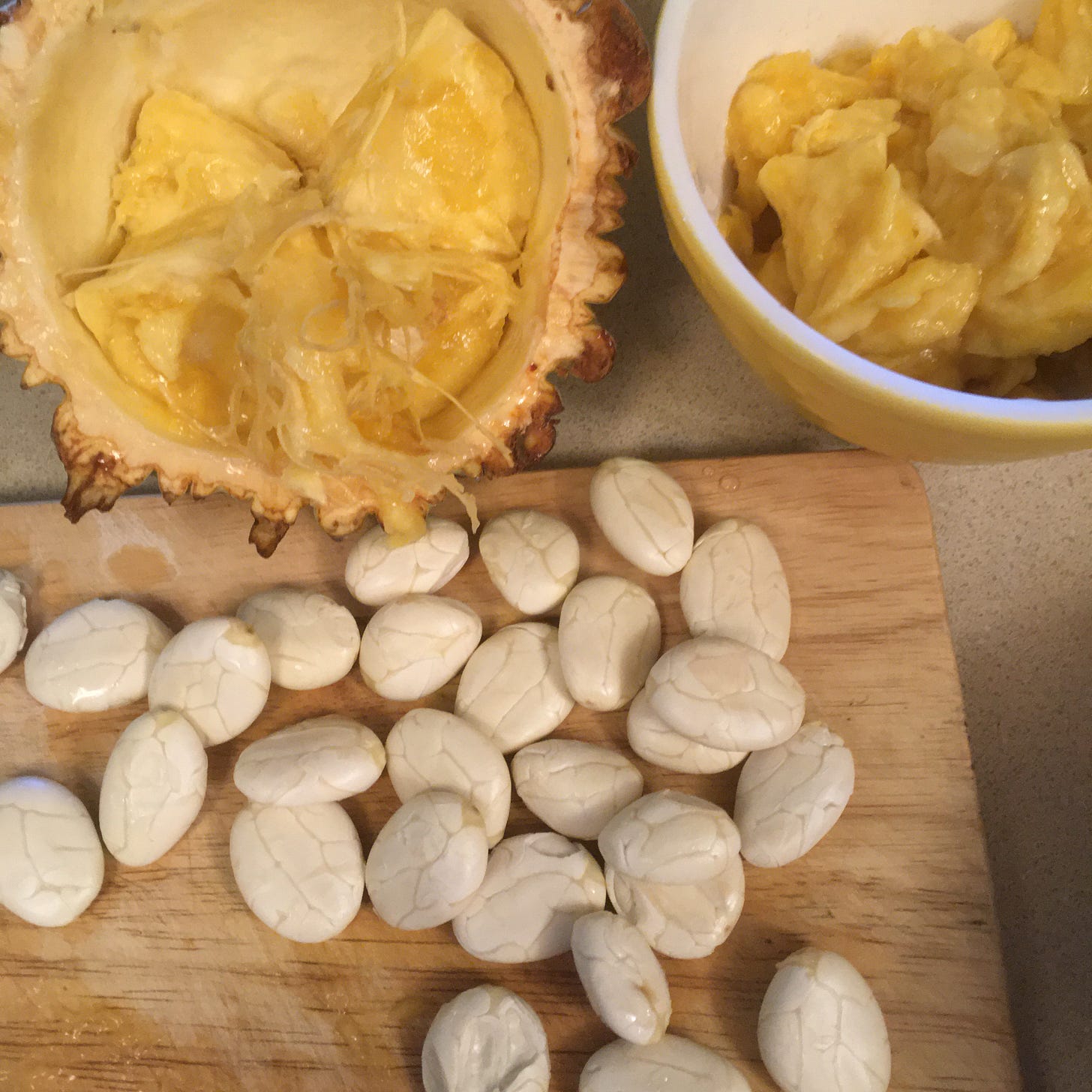
I wrote about this intriguing cacao cousin in this post from last year, sharing botanical observations, evangelizing about the impressive nutritional content, sharing botanical observations, and indulging in a few philosophical musings. In rereading now, I’m amused that I fell again this year into the trap I warned about last year. Even though I should know better, I was expecting more family resemblance and unfairly compared bicolor to its cousin.
This tropical tree goes by many names, last year I used balamte' out of respect for the Mayan name. Pataxte is a popular name in Mexico, where this fruit is perhaps most commonly used. Here on this island, it is becoming known by the name jaguar cacao (a very cool name, but there again it invites unfair comparison), so I will use that name here.
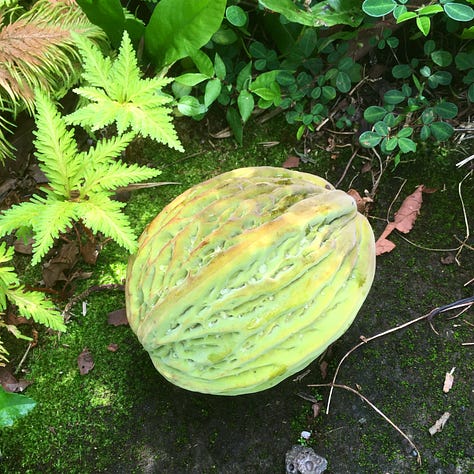

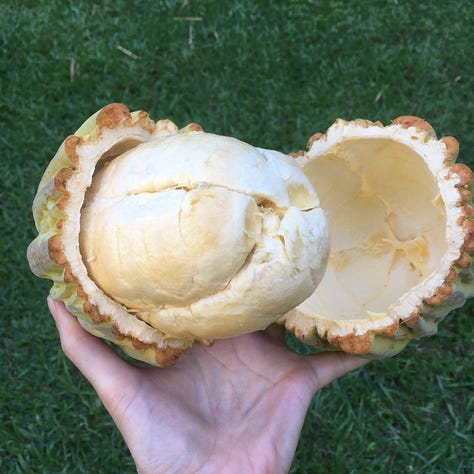
Unlike cacao, jaguar cacao drops its pod when they are ready. All our five pods did not ripen at the same time; our tree doling out one pod about every 1-2 weeks.
Pod 1 - gave to a neighbor
Pod 2 - unfermented seed experiments
Pod 3 - 7-day fermentation experiments
Pod 4 - 4-day fermentation experiments
Pod 5 - promised to a fruit enthusiast
This year we discovered an easier way to open the pods, which are much more robust than cacao pods. Last year I used my pocket boy saw to patiently grate through. Inspired by a post on Instagram (wish I remembered to credit), this year we used the back side of a machete to crack the pod - hitting it around the circumference until it cracked open. Much faster and more efficient!
Unfermented
Last year, I processed jaguar cacao by including the seeds in a regular cacao fermentation. I dried the seeds along with the cacao, but ran into problems in the winnowing stage. The seed shells are difficult to break and winnow by hand. One of my goals for this season was to play with extracting the seeds from the shells before drying and roasting, obviating the potential for difficult winnowing.
The seeds of jaguar cacao are bland, not bitter or astringent, and therefore do not need to be fermented. So my plant for Pod 2 was to extract the fresh seeds, then dry and roast them.
I started by simply using a knife to cut the fruit and the leathery shell off of the seeds. It is not hard to extract full seeds this way, but I ended up cutting most in half to speed the process. While a straightforward task, handling these seeds is a strange experience. They are slippery and the inside has a bubbly layer, like air pockets.
After drying in a dehydrator, I roasted the seeds in a pan on the stove, sampling over time. The result was crunchy bits reminiscent of cashew. Ah, I thought, delicious as an inclusion in dark chocolate! (Wanting to combine Theobroma plants into treats has been a dream from the moment I read about the cacao relatives.) I found that the part of the seed called the radical (the sprout) was hard and unpleasant to chew, so I removed them.
I mixed some of the nibs into tempered chocolate right away, but the result was not all that I had hoped. The nibs have an interesting flavor; I think of it as a fruity flavor, aromatic and possibly floral. I’m not sure how to describe it. Anyway, the nibs and the chocolate didn’t get along. Some friends I gave tastes to did not agree and thought it just tasted like cashew nits in chocolate. But it may be that they perceived the strange flavor but thought it came from the chocolate not the inclusion.
The nibs were a better match for my dark mylk chocolate, and I was quite happy with a bonbon I made using these jaguar nibs in a vegan mylk chocolate ganache, with additional flavors of vanilla and cinnamon.
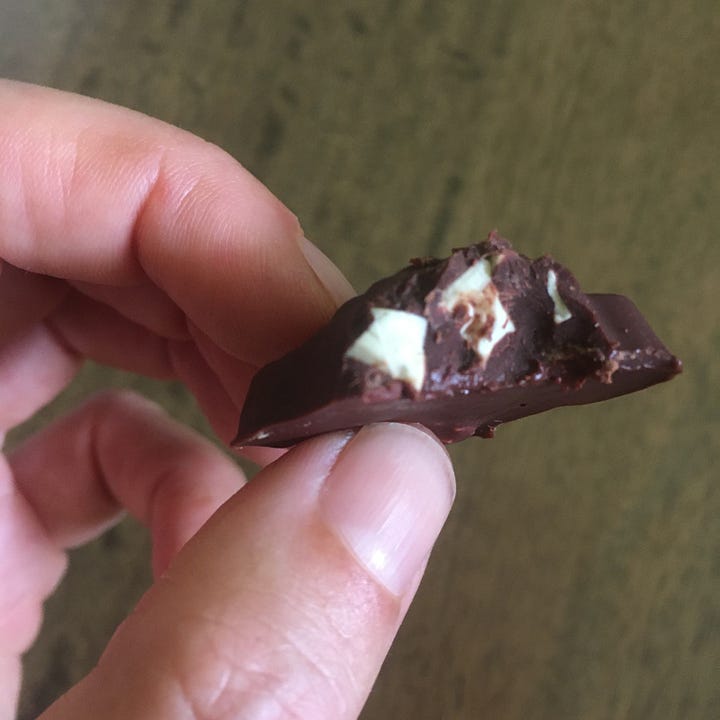
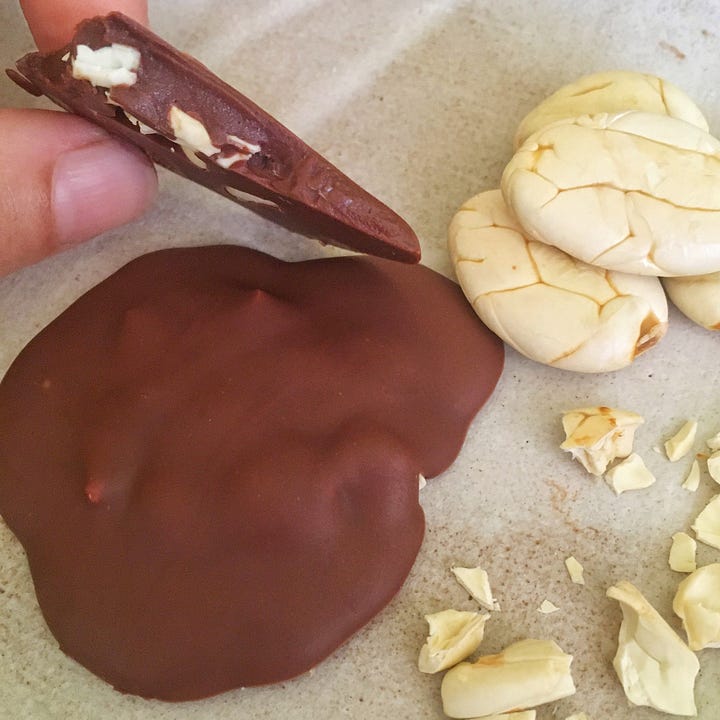
Fermented 7 days
Since working with this fruit is still new to me, I thought I would try an experiment: how would the fermented nibs be different? Since the unfermented seeds don’t have a ton of flavor, I would expect that acids from the ferment and perhaps enzymatic break-down of seed macromolecules would give them more character. Perhaps fermentation would lessen the strange fruity/floral flavor.
After extracting the fresh seeds and fruit from Pod 3, I fermented them in a Mason jar. Like a cacao fermentation, I started the ferment at about 95°F for two days to allow the yeasts a good environment to work. I then mixed the seeds, rubbing them together to loosen some of the copious fruit, which I collected and composted. After mixing, I turned up the heat to 115°F for a day, mixed again, then adjusted the heat to 120°F. I mixed daily, and stopped the fermentation after seven days.
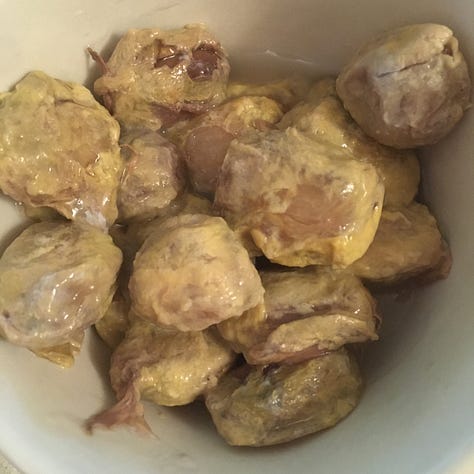
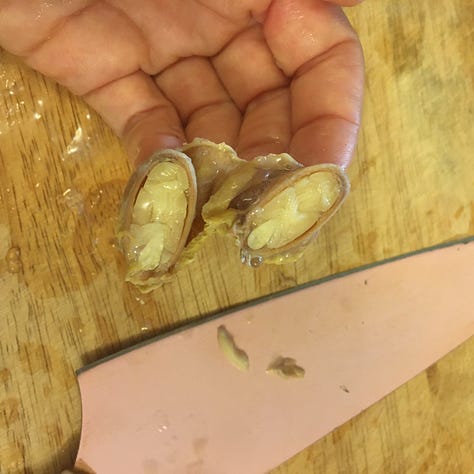
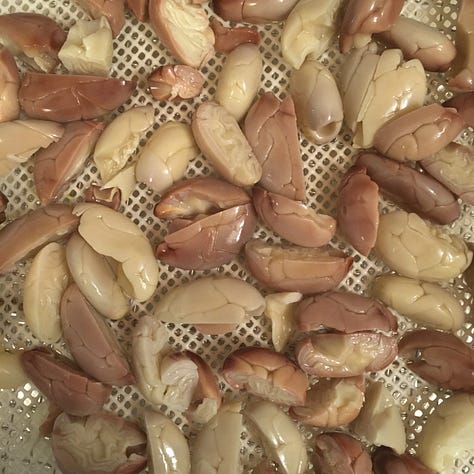
Not wanting to winnow the tough shells after drying, I cut open each fruit pouch to extract the seed. I discarded the fruit and the radical. I washed the seed bits in water and dehydrated them until they seemed dry, about 6 hours at 105°F.
I roasted the seeds in my convection oven at 300°F for 12 minutes. The color changed to an even medium brown. This suggests molecular changes, since the roasted color of the unfermented seeds remains off-white. As expected, the roast mellowed the acidic flavor and added a toasted flavor.
The flavor of the fermented seeds roasted is a bit more similar to cacao, but still different. The unfermented, unroasted seeds tasted sour, vinegary. Roasting brought out nutty and umami flavors but still with a lot of acidity and a fruity flavor evoking the fresh fruit. To me, it unfolds like this: first a cacao nib, then acidic with umami, and at the end the fruit/floral note mentioned above. Tasting these, my mind kept searching for an familiar association that took a while to come. I finally grasped it: a Cheez-It cracker.
This processing makes the seeds delicious to snack on, when you get used to the flavor. They are pretty good as a dark chocolate inclusion, too. Not too far off from a miso chocolate combo.
Fermented 4 days
I liked the fermented nibs, but I wondered if they were over-fermented. Tasting notes of cheese in cacao usually means just that. Considering that white-bean cacao (like criollo) is usually fermented a shorter time, perhaps jaguar cacao should be, too.
I opened Pod 4 and started the ferment at about 95°F for two days, then mixed and raised the temperature to 120°F for a day, then mixed and raised the temperature to 122°F for a day. Checking the inside of one seed, it had more pronounced grooves and tasted a bit sour and a bit fruity. I decided to stop the ferment, since I wanted a noticeable difference between this fermented batch and the previous one.
Just like the last batch, I cut the fruit pouches in half to extract the seeds, took off the radical, washed them in water, and dried them in a dehydrator (105°F for about 6 hours). I roasted them just as the others: in my convection oven at 300°F for 12 minutes.
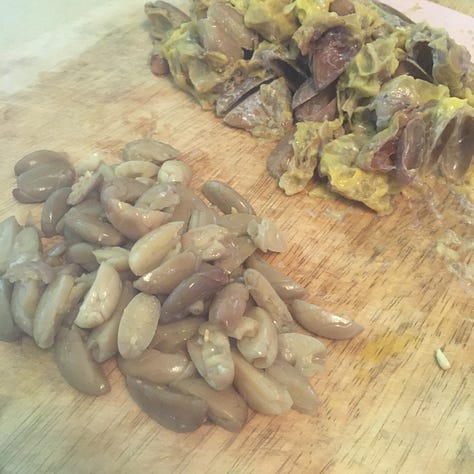
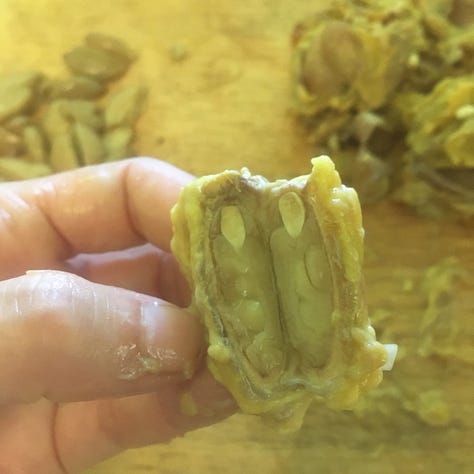
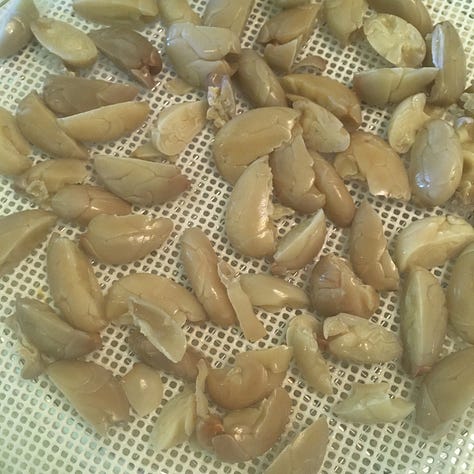
Comparison
Tasting all three roasted batches, I am surprised by a few observations. First, I am struck by the color. The unfermented beans stay white when roasting, while the fermented beans become darker (continuing a color change started in fermentation). I assume this is evidence for the breakdown of macromolecules into simple molecules that recombine (in Maillard reactions, etc.) during roasting. It is strange that the 4-day roast is darker than the 7-day ferment after roasting, but that could be a fluke. Even though I thought I was roasting in the same way, the sample sizes are so small they invite anomalies.
The unfermented beans taste like a less oily cashew with that additional fruity/floral taste I can’t describe. As I have mentioned, I don’t love this flavor in the fruit or the seed. Roasting mitigates it, and time in a melanger would likely lessen it more.
It is strange to me that the 4-day and 7-day fermented, roasted seeds taste so similar. I was expecting much more difference. They both have a striking acidity, although the 4-day is a bit milder, as expected. I don’t remember the seeds I fermented with cacao last year tasting so acidic. Lower acidity last year might have come from the lower fruit:seed ratio or the slow drying in the shell.
Of these, my favorite is the roasted, unfermented as a nutritious snack. I can envision mixing them into an addictive a trail mix with cacao and tart cherries. As a chocolate inclusion, I prefer the roasted, 4-day fermented seeds.
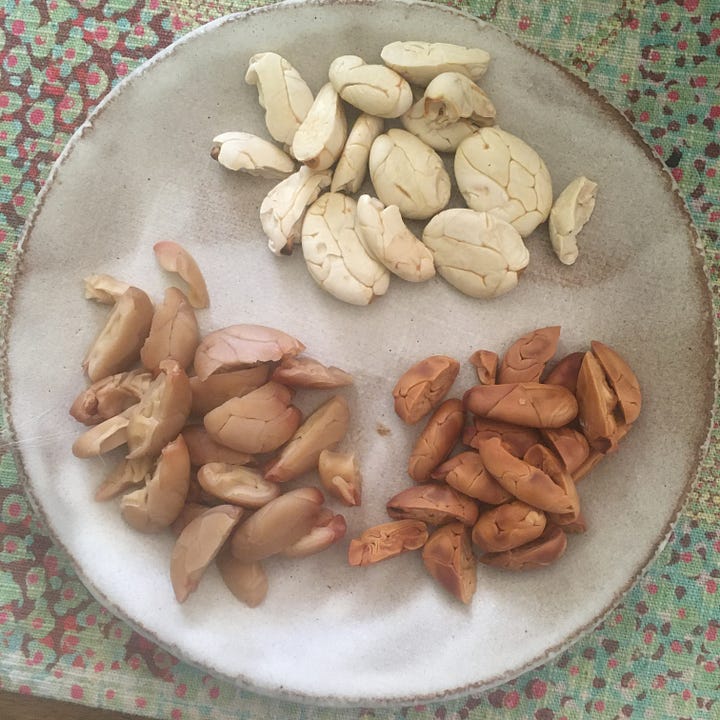
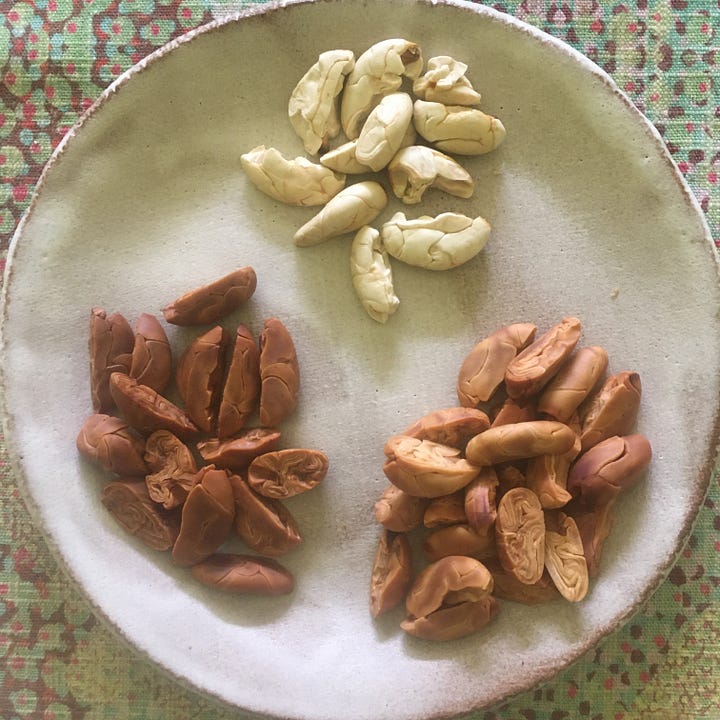
Notes to myself for next year’s experiments:
take timepoints in one fermentation to allow a more direct comparison
start the time points earlier
ferment with less fruit to try to lower acidity
dry more slowly to lower acidity
heat-treat the seeds instead of fermenting to attempt to trigger the enzymatic reactions without the microbial acids
Looking forward to next fall - hopefully my awesome trees will provide me with more fruit to play with!
Jaguar cacao in Hawai'i
I notice jaguar cacao is being planted more and more on the island, and many people will need to figure out how to process and work with this fruit. I hope my experiments will help!
I recommend using jaguar cacao as its own seed, acting as a nut in trail mixes, butter/spreads, and toppings. These seeds were and our traditionally featured in drinks, another area to explore.
As far as my dream to use the jaguar cacao as chocolate inclusions, that’s good, but maybe not the excellent combo I hoped for - at least not yet. I found that adding fruity spices (cinnamon and vanilla in this case) helped connect the flavors.
Some craft chocolate makers use jaguar cacao beans sourced from Mexico to make chocolate-like bars. Perhaps my excitement to try these created too high expectations, but I honestly was a bit disappointed in the bars I tried. Jaguar cacao chocolate is very mild, pleasant, and nutty - but misses much of what I love about chocolate. It tastes like a caramelized white chocolate. Not bad, but not to my taste. Madre Chocolate on O'ahu makes a beautiful swirl bar with dark chocolate and jaguar cacao “chocolate.” This is a wonderful solution to get these cousins together in a way that can be flattering to each.
I look forward to collaborating with other growers to establish processing protocols and recipes that work for Hawai'i. Do you have jaguar cacao experience? Let us know in the comments!





Always fun to read your experiments and experiences Raven!
Man, I would love to try this!